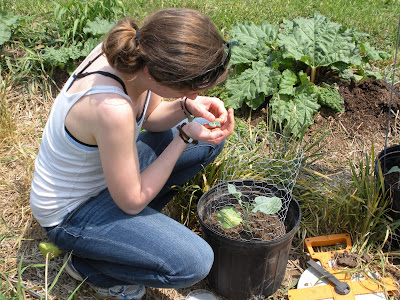After many conversations between the Columbus and Wooster students over the video link, we decided on the focal habitats and methods for our study. We also had much assistance from our professors (Dr. Canas and Dr. Grewal) as well as our TA (Harit).
Our goal for this project was to assess the biological control services provided by organisms in three different habitats (conventional farm, community garden, and forest). We were interested in looking at both above and below ground control.
The below ground method involved placing larvae into cages and burying them in the soil. They were left there for 2-3 days, then retrieved and checked for fungal, bacterial, or nematode infection.
 For surveying biological control services that occur above or on the ground we used three methods: Larvae on sticky cards, larvae hanging in cages, and aphid counts.
For surveying biological control services that occur above or on the ground we used three methods: Larvae on sticky cards, larvae hanging in cages, and aphid counts.The larvae on sticky cards was a method that came up with ourselves, and I am unaware if this method had been used before to survey biological control services. The sticky cards are usually used to survey for flying insects in fields (lady beetles for example). We decided to stick the larvae on them and see if any predators attacked them. This method was not without flaws though. We found that the larvae were very active and were able to escape from the glue on the trap. Our solution was to use scotch tape to keep the larvae in place, and it worked in some cases.

We also placed the larvae in hanging cages, and we were hoping that they might be attacked by parasitoids.
 The final method, aphids, is a method that is commonly used to asses biological control services in fields. This method involves placing plants infested with aphids in the field. One is covered with a net to exclude predators, but still be affected by the weather conditions. The other plant is left open (without a net) so predators are able to munch away on the aphids as they please. The idea is to compare the number of aphids on that closed plant with the number of aphids on that open plant after a period of time in the field (one week in our case) to get an idea of the effect predators have on aphid colonies. We would expect to have higher aphid counts in the closed plant treatments.
The final method, aphids, is a method that is commonly used to asses biological control services in fields. This method involves placing plants infested with aphids in the field. One is covered with a net to exclude predators, but still be affected by the weather conditions. The other plant is left open (without a net) so predators are able to munch away on the aphids as they please. The idea is to compare the number of aphids on that closed plant with the number of aphids on that open plant after a period of time in the field (one week in our case) to get an idea of the effect predators have on aphid colonies. We would expect to have higher aphid counts in the closed plant treatments.

The class is now busy analyzing the data and putting together presentations!



No comments:
Post a Comment